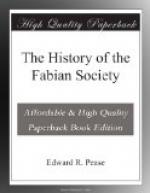Another factor in the thought of those days attracted but little attention in the Press, though there is a long article in the “Spectator” at the beginning of 1882 on “the ever-increasing wonder” of that strange faith, “Positivism.” It is difficult for the present generation to realise how large a space in the minds of the young men of the eighties was occupied by the religion invented by Auguste Comte. Of this however more must be said on a later page.
But perhaps the most significant feature in the periodical literature of the time is what it omits. April, 1882, is memorable for the death of Charles Darwin, incomparably the greatest of nineteenth-century Englishmen, if greatness be measured by the effects of his work on the thought of the world. The “Spectator” printed a secondary article which showed some appreciation of the event. But in the monthly reviews it passed practically unnoticed. It is true that Darwin was buried in Westminster Abbey, but even in 1882, twenty-three years after the publication of the “Origin of Species,” evolution was regarded as a somewhat dubious theorem which respectable people were wise to ignore.
In the monthly reviews we find the same odd mixture of articles apposite to present problems, and articles utterly out of date. The organisation of agriculture is a perennial, and Lady Verney’s “Peasant Proprietorship in France” ("Contemporary,” January, 1882), Mr. John Rae’s “Co-operative Agriculture in Germany” ("Contemporary,” March, 1882), and Professor Sedley Taylor’s “Profit-Sharing in Agriculture” ("Nineteenth Century,” October, 1882) show that change in the methods of exploiting the soil is leaden-footed and lagging.
Problems of another class, centring round “the Family,” present much the same aspect now as they did thirty years ago. In his “Infant Mortality and Married Women in Factories,” Professor Stanley Jevons ("Contemporary,” January, 1882) proposes that mothers of children under three years of age should be excluded from factories, and we are at present perhaps even farther from general agreement whether any measure on these lines ought to be adopted.
But when we read the articles on Socialism—more numerous than might be expected at that early date—we are in another world. Mr. Samuel Smith, M.P., writing on “Social Reform” in the “Nineteenth Century” for May, 1883, says that: “Our country is still comparatively free from Communism and Nihilism and similar destructive movements, but who can tell how long this will continue? We have a festering mass of human wretchedness in all our great towns, which is the natural hotbed of such anarchical movements: all the great continental countries are full of this explosive material. Can we depend on our country keeping free from the infection when we have far more poverty in our midst than the neighbouring European States?” Emigration and temperance reform, he thinks, may avert the danger.




